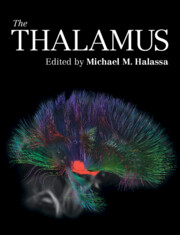Book contents
- The Thalamus
- The Thalamus
- Copyright page
- Contents
- Contributors
- Preface
- Section 1: History
- Section 2: Anatomy
- Section 3: Evolution
- Section 4: Development
- Section 5: Sensory Processing
- Chapter 9 Thalamocortical Interactions in the Primary Visual Cortex
- Chapter 10 Corticothalamic Feedback in Vision
- Chapter 11 The Vibrissa Sensorimotor System of Rodents: A View from the Sensory Thalamus
- Chapter 12 Corticothalamic Pathways in the Somatosensory System
- Chapter 13 Thalamocortical Circuits for Auditory Processing, Plasticity, and Perception
- Section 6: Motor Control
- Section 7: Cognition
- Section 8: Arousal
- Section 9: Computation
- Index
- References
Chapter 12 - Corticothalamic Pathways in the Somatosensory System
from Section 5: - Sensory Processing
Published online by Cambridge University Press: 12 August 2022
- The Thalamus
- The Thalamus
- Copyright page
- Contents
- Contributors
- Preface
- Section 1: History
- Section 2: Anatomy
- Section 3: Evolution
- Section 4: Development
- Section 5: Sensory Processing
- Chapter 9 Thalamocortical Interactions in the Primary Visual Cortex
- Chapter 10 Corticothalamic Feedback in Vision
- Chapter 11 The Vibrissa Sensorimotor System of Rodents: A View from the Sensory Thalamus
- Chapter 12 Corticothalamic Pathways in the Somatosensory System
- Chapter 13 Thalamocortical Circuits for Auditory Processing, Plasticity, and Perception
- Section 6: Motor Control
- Section 7: Cognition
- Section 8: Arousal
- Section 9: Computation
- Index
- References
Summary
The somatosensory thalamocortical system has proven a tractable model for dissecting how different neuronal populations sculpt bidirectional information exchange between the thalamus and the cortex. This chapter reviews corticothalamic (CT) pathways from layers 5 (L5) and 6 (L6) of the primary somatosensory (S1) cortex to first-order ventroposterior (VP) and higher-order posterior medial (POm) somatosensory thalamic nuclei. With a focus on insights gained from recent cell-type–specific approaches in rodent models, we contrast L5 and L6 CT pathways at the scales of network architecture, anatomical connectivity, and physiological characteristics. We further compare the distinct feedforward inhibitory circuits engaged by L6 and L5 CT pathways, which involve the thalamic reticular nucleus and extrathalamic inhibitory nuclei, respectively. Where data exist, we discuss short- and long-term synaptic dynamics of the specific CT circuits. We close with a discussion of the proposed functions of these distinct pathways in conveying “top-down” cortical signals for both the modulation of thalamic processing of sensory information and the transmission of information between cortical regions.
Keywords
- Type
- Chapter
- Information
- The Thalamus , pp. 221 - 236Publisher: Cambridge University PressPrint publication year: 2022



